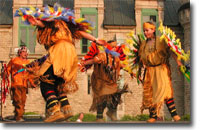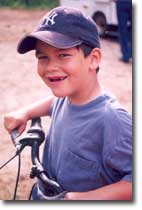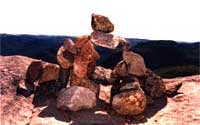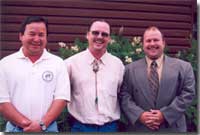|

|
The Abenakis :
 The Abenakis belong to the Algonquian linguistic family.
In Quebec, there are over 2,000 Abenaki, of whom close to 400 live on reserve. Their lands are located on the south shore of the St. Lawrence River near Trois-Rivières. There are two Abenaki communities in Quebec: Odanak and Wôlinak. The Abenakis belong to the Algonquian linguistic family.
In Quebec, there are over 2,000 Abenaki, of whom close to 400 live on reserve. Their lands are located on the south shore of the St. Lawrence River near Trois-Rivières. There are two Abenaki communities in Quebec: Odanak and Wôlinak.
In earlier times, the Abenakis lived by hunting, fishing, trapping, berry-gathering and growing crops of corn, beans, squash, potatoes and tobacco.
Did you know that Odanak is home to one of Quebec's largest Aboriginal Museums?

|
The Algonquins :
The Algonquins belong to the Algonquian linguistic family. In Quebec, there are more than 9,000 Algonquins, of whom just over 5,000 live on reserve. Their lands are located in the Abitibi-Témiscamingue Region. There are nine Algonquin communities in Quebec: Eagle Village-Kipawa, Hunter's Point, Kitcisakik, Kitigan Zibi, Lac-Simon, Pikogan, Rapid Lake, Timiskaming and Winneway.
In earlier times, the Algonquins lived mainly by hunting, fishing and gathering, but also practised agriculture.
Did you know that the Algonquins word "achigan" means "one who struggles"?

|
The Atikamekw :
The Atikamekw belong to the Algonquian linguistic family. In Quebec, there are over 6,000 Atikamekw, most of whom live on reserve. Their lands are located between those of the Innu, Algonquin and Cree nations in the regions of Lanaudière, Mauricie and Central Quebec. There are currently three Atikamekw communities in Quebec: Obedjiwan, Wemotaci and Manawan. Coucoucache is also an Atikamekw reserve but is uninhabited.
In the 17th century, their geographic location placed them in a favourable position for bartering with neighbouring nations. Their diet consisted of game, fish and corn that they cultivated.
Did you know that "Atikamekw" means "whitefish"? Did you also know that the Atikamekw discovered maple syrup?

|
The Crees :
 The Crees belong to the Algonquian linguistic family. In Quebec, there are over 14,800 Crees, whom over live 13,000 on reserve. The Crees are signatories of the James Bay and Northern Quebec Agreement. Their lands are located in the James Bay Basin, with a portion near Chibougamau. There are nine Cree communities in Quebec: Chisasibi, Eastmain, Mistissini, Nemiscau, Oujé-Bougoumou, Waskaganish, Waswanipi, Wemindji and Whapmagoostui. The Crees belong to the Algonquian linguistic family. In Quebec, there are over 14,800 Crees, whom over live 13,000 on reserve. The Crees are signatories of the James Bay and Northern Quebec Agreement. Their lands are located in the James Bay Basin, with a portion near Chibougamau. There are nine Cree communities in Quebec: Chisasibi, Eastmain, Mistissini, Nemiscau, Oujé-Bougoumou, Waskaganish, Waswanipi, Wemindji and Whapmagoostui.
In earlier times, the Crees were mainly nomadic and lived on game and fish.
Did you know that Cree communities are seeing significant economic growth in the highway and air transportation, construction and ethno-cultural tourism sectors? Did you also know that over 30% of Crees in Quebec still earn their living today from traditional activities related to hunting, fishing and trapping 1?
1. Source: Indiana Marketing Website

|
The Hurons-Wendat :
 The Hurons-Wendat belong to the Iroquoian linguistic family. There are more than 3,000 Hurons-Wendat in Quebec, of whom just over a third live on reserve. Their lands are located very close to Quebec City. The only Huron-Wendat community in Quebec is called Wendake. The Hurons-Wendat belong to the Iroquoian linguistic family. There are more than 3,000 Hurons-Wendat in Quebec, of whom just over a third live on reserve. Their lands are located very close to Quebec City. The only Huron-Wendat community in Quebec is called Wendake.
In the past, the Hurons-Wendat lived mainly on agriculture and the trading of corn and tobacco.
Did you know that the
Hurons-Wendat introduced popcorn to Europeans? The Hurons called it "ogarita", whereas the French called it "blé fleuri" (wheat flowers).

|
The Innus :
 The Innus, also called the Montagnais, belong to the Algonquian linguistic family. In Quebec, there are more than 15,600 Innus, of whom over 11,000 live on reserve. It is the largest First Nation in Quebec. Their lands extend from the North Shore to Lac-Saint-Jean. There are nine Innu communities in Quebec: Betsiamites, Essipit, La Romaine, Mashteuiatsh, Mingan, Natashquan, Pakua Shipi, Matimekosh–Lac-John and Uashat–Maliotenam. The Innus, also called the Montagnais, belong to the Algonquian linguistic family. In Quebec, there are more than 15,600 Innus, of whom over 11,000 live on reserve. It is the largest First Nation in Quebec. Their lands extend from the North Shore to Lac-Saint-Jean. There are nine Innu communities in Quebec: Betsiamites, Essipit, La Romaine, Mashteuiatsh, Mingan, Natashquan, Pakua Shipi, Matimekosh–Lac-John and Uashat–Maliotenam.
In earlier times, the Innus led a traditional nomadic way of life.
They used animal bones and skins to make clothing and weapons.
Did you know that the Jesuits set up their first mission among the Innus in 1632?

|
The Inuit :
 The Inuit belong to the Eskimo-Aleut linguistic family. In Quebec, there are over 10,000 Inuit, of whom more than 9,500 live in northern villages. The Inuit were among the signatories of the James Bay and Northern Quebec Agreement (JBNQA). There are 14 Inuit communities in the Nunavik territory and two communities in the James Bay Basin. They are: Akulivik, Aupaluk, Chisasibi, Inukjuak, Ivujivik, Kangiqsualujjuaq, Kangiqsujuaq, Kangirsuk, Killiniq, Kuujjuaq, Kuujjuarapik, Puvirnituq, Quaqtaq, Salluit, Tasiujaq and Umiujaq. The Inuit belong to the Eskimo-Aleut linguistic family. In Quebec, there are over 10,000 Inuit, of whom more than 9,500 live in northern villages. The Inuit were among the signatories of the James Bay and Northern Quebec Agreement (JBNQA). There are 14 Inuit communities in the Nunavik territory and two communities in the James Bay Basin. They are: Akulivik, Aupaluk, Chisasibi, Inukjuak, Ivujivik, Kangiqsualujjuaq, Kangiqsujuaq, Kangirsuk, Killiniq, Kuujjuaq, Kuujjuarapik, Puvirnituq, Quaqtaq, Salluit, Tasiujaq and Umiujaq.
Before the arrival of Europeans, the Inuit in Nunavik were nomads and lived on resources found on land or in the ocean. Their diet changed according to the season.
Did you know that many anthropologists consider the Inuit one of the most inventive people on earth? Among the things they developed were protective glasses made from ivory and antler bone, which they used to shield themselves from the blinding rays of the sun reflected off the snow.

|
The Maliseet :
 The Maliseet belong to the Algonquian linguistic family. In Quebec, there are 764 Maliseet, but only two live on reserve. Their lands are located in the Lower St. Lawrence Region near Rivière-du- Loup. There are two Maliseet communities in Quebec: Cacouna and Whitworth. The Maliseet belong to the Algonquian linguistic family. In Quebec, there are 764 Maliseet, but only two live on reserve. Their lands are located in the Lower St. Lawrence Region near Rivière-du- Loup. There are two Maliseet communities in Quebec: Cacouna and Whitworth.
In earlier times, the Maliseet were semi-nomadic. They lived by hunting and fishing, but also grew corn.
Did you know that the Maliseet lived in New Brunswick until the 16th century?

|
The Micmacs :
 The Micmacs belong to the Algonquian linguistic family. In Quebec, there are more than 4,900 Micmacs, of whom over 2,400 live on reserve. Their lands are located in the Gaspé Peninsula. There are three Micmac communities in Quebec: Listuguj, Gesgapegiag and Gaspé (Gespeg). However, Gespeg is not considered a reserve. The Micmacs belong to the Algonquian linguistic family. In Quebec, there are more than 4,900 Micmacs, of whom over 2,400 live on reserve. Their lands are located in the Gaspé Peninsula. There are three Micmac communities in Quebec: Listuguj, Gesgapegiag and Gaspé (Gespeg). However, Gespeg is not considered a reserve.
In earlier times, the Micmacs were nomadic and lived by fishing, hunting, trapping and berry-gathering.
Did you know that the word "gaspé" means "land's end"?

|
The Mohawks :
The Mohawks belong to the Iroquoian linguistic family. In Quebec, there are nearly 11,400 Mohawks, of whom more than 8,700 live on reserve. Their lands are located on the outskirts of Montreal. There are three Mohawk communities in Quebec: Kahnawake, Kanesatake and Akwesasne. A portion of the latter is located in Ontario. Doncaster is also a Mohawk reserve but is uninhabited.
In earlier times, the Mohawks lived mainly by farming, hunting, fishing, food-gathering and trading agricultural produce and crafts.
Did you know that in earlier times the Mohawks worked as paddlers for many transport companies? Their ability to negotiate rapids and turbulent waters helped a British expedition make its way up the Nile River to Khartoum in the Sudan1.
1. Source: Indiana Marketing Website.

|
The Naskapis :
The Naskapis are part of the Algonquian linguistic family. There are close to 600 Naskapis in Quebec, most of them living on reserve. They signed the James Bay and Northern Quebec Agreement in 1978. Their lands are located north of Schefferville, near Labrador. There is only one Naskapi community in Quebec: Kawawachikamach.
In earlier times, the Naskapis were a nomadic people who lived almost entirely by hunting caribou, seals and migratory birds and by ice fishing. Agriculture was not possible in these northern lands.
Did you know that the Naskapis once lived in Kuujjuaq and endured a severe famine in 1949?
|

Maps - The Nations
Videos and Multimedia
Ressources, Businesses, A new Economy 
Adventure Mikuan II tourism company 

Demographical data (according to Indian registry)
Indian and Inuit Populations in Quebec as of December 31, 2005
Map - The Nations

Quebec Indian and Inuit Communities Guide
|
|